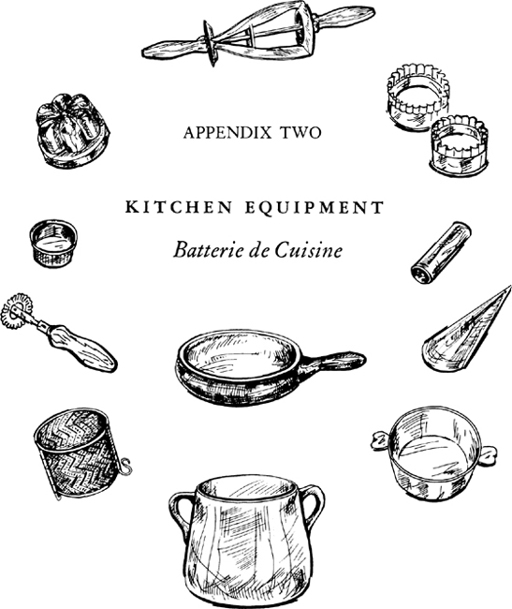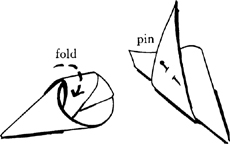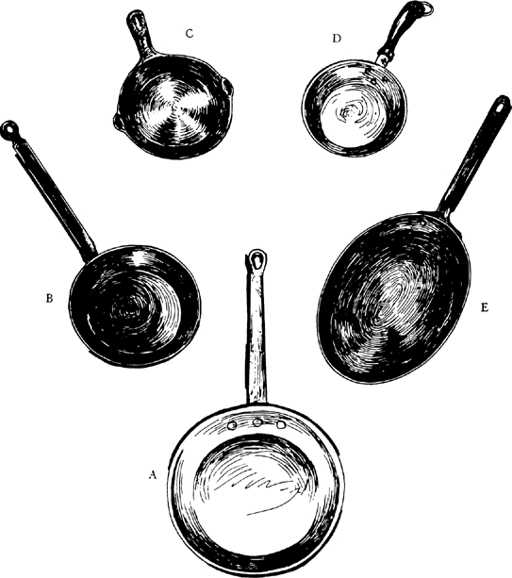Mastering the Art of French Cooking, Volume 2 (218 page)
Read Mastering the Art of French Cooking, Volume 2 Online
Authors: Julia Child

Secure cone either by bending points X, Y, and Z down inside, or by using a straight pin |
|
Appendices
LIST OF STUFFINGS FOR MEATS AND VEGETABLES
STUFFINGS WITH MUSHROOMS
Mushroom duxelles with onions, cream cheese, and parsley
—for stuffed vegetables—in the stuffed eggplant recipe, Volume I, page 502.
Mushroom duxelles and spinach, farce Viroflay
—for stuffed lamb and veal—in the stuffed shoulder of lamb recipe.
Mushrooms, onions, and ham
—for stuffed lamb, veal, or chicken, and for stuffed vegetables—in the lamb section, Volume I, page 337.
Mushroom, giblets, bread crumbs, and cream cheese
—for chicken, veal, and stuffed vegetables—in the roast chicken section, Volume I, page 252.
Mushrooms and kidneys, Mushrooms and chicken livers, Mushrooms and ground lamb, Mushrooms and forcemeat
—see following section.
STUFFINGS WITH MEAT
Sausage, ham, chard, and bread crumbs
—for meats and stuffed vegetables—in the
paupiettes
of beef.
Sausage, ham, and rice
—for meats and stuffed vegetables—in the stuffed cabbage recipe.
Sausage and apple
—for duck, goose, and pork—in the roast duck recipe, Volume I, page 275.
Sausage and chestnuts
—for duck, goose, turkey, and pork—in the roast goose recipe, Volume I, page 286.
Sausage, rice, and apricots, farce Trébizonde
—for duck, goose, pork, and turkey—in the suckling pig recipe.
Ground pork, onions, herbs, and bread crumbs, farce de porc
—for stuffed meats and vegetables—in the stuffed lamb section, Volume I, page 336.
Ground pork with ham, truffles, and foie gras
—for stuffed veal and chicken, or for use as a
pâté
mixture—in the veal section,
veau en feuilletons
.
Ground braised beef, onions, and herbs
—for stuffed vegetables, or as a meat loaf—in the
stuffed cabbage recipe
.
Ground braised beef and chard
—for stuffed vegetables, as a meat loaf, or as sausages—in the sausage section,
les tous nus
.
Ground leftover veal, turkey, or pork with onions and herbs
—for stuffed vegetables or as a meat loaf—in the eggplant section.
Veal, ham, rice, and chard or spinach
—for stuffed veal or lamb—in the
breast of veal recipe
.
Forcemeat and mushrooms, boudin blanc, farce normande
—for chicken, turkey, or veal—in the
poached chicken section
.
Ground lamb, olives, and onions
—for stuffed lamb and stuffed vegetables—in the lamb section, Volume I, page 338.
Ground lamb, salmon, anchovies, and onions
—for stuffed lamb and stuffed vegetables—in the lamb section, Volume I, page 338.
Ground lamb, eggplant, mushrooms, rice, and herbs
—for stuffed lamb, stuffed vegetables, and as a meat loaf—the
Moussaka
recipe, Volume I, page 349.
Kidneys, rice, and herbs
—for lamb or veal—in the stuffed lamb section, Volume I, page 337.
Kidneys and mushrooms
—for stuffed lamb or veal—in the
lamb section
.
Foie gras and prunes
—for stuffed duck, goose, or turkey—in the stuffed goose recipe, Volume I, page 284.
Foie gras and truffles
—for
filet
of beef, veal, or chicken—in the
filet
of beef recipe, Volume I, page 304.
Chicken livers, rice, foie gras, and truffles, farce à la d’Albuféra
—for chicken, turkey, and veal—in the
poached chicken section
.
Chicken livers, mushrooms, rice, and puréed cooked garlic, farce évocation d’Albuféra
—for chicken, turkey, veal, and stuffed vegetables—in the
poached chicken section
.
Chicken-liver mixture for stuffings, sausages, and pâtés
—in the
pâté
section.
Chicken giblets, herbs, crumbs, and cream cheese
—for veal, chicken, turkey, and stuffed vegetables—in the roast chicken recipe, Volume I, page 243. The same, with mushrooms, Volume I, page 252.
MEATLESS AND MUSHROOMLESS STUFFINGS
Rice, onions, and cheese
—for stuffed vegetables—in the
stuffed onion recipe
.
Rice and chopped peppers, tomato topping
—for stuffed vegetables—in the
stuffed zucchini recipe
.
Rice, garlic, and herbs
—for stuffed meats and vegetables—in the
paupiette
of beef recipe
.
Chopped olives, pimentos, and herbs
—for
paupiettes
of meat—in the
beef
paupiettes
.
Garlic and herbs
—for
paupiettes
of meat, and as a flavoring for boned red meats—in the lamb section, Volume I, page 336.
Chopped peppers, onions, and mustard bread crumbs
—for
paupiettes
of meat—in the
beef
paupiettes
.
Almonds, cheese, and bread crumbs
—for stuffed onions, or zucchini—in the
stuffed zucchini recipe
.
Eggplant, peppers, onions, tomatoes, and herbs
—for stuffing cold vegetables—in the vegetable chapter.

The next pages contain an illustrated roundup of some kitchen equipment we find useful, so that you will see it all in one place rather than scattered throughout the two volumes.
Some of these implements are standard American, others are professional American, still others can be found in import shops or mail-order catalogues, and some are things to look out for if you go abroad and are browsing around in restaurants or butcher supply houses near the central markets. As always, we advise you to look for solid, practical, professional equipment designed by people in the chef business who sell to chefs. If you have trouble locating good equipment in your area, ask your butcher or the owner and chef of the best restaurant in town.
FRYING PANS
For browning meats and vegetables and for general sautéing, the heavyduty professional frying pan with its long handle and sloping 2-inch sides is the best shape. American cast-aluminum models (A and D) come either with plain or no-stick interiors. The French
poêle
(B) is of
tôle épaisse
(very thick sheet metal); one with a bottom diameter of 7 to 7½ inches is ideal for omelettes. The oval cast-iron pan (E),
poêle à poissons
, is as useful for browning roasts as it is for sautéing fish. The short-handled cast-iron American skillet (C) is also good in the oven, and is the pan to use for
pommes Anna;
the same shape can be found with an enameled surface, making it ideal for cooking in white wine, or for storing and serving stews or sautés.
You should have at least three sizes of frying pans—a large one 11 inches across its top diameter, a medium, or 10-inch, pan, and a smaller, 7- to 8-inch, pan for single servings and
crêpes
. You will probably end up with many more, some of one material, some of another, and each your pet for certain techniques.



